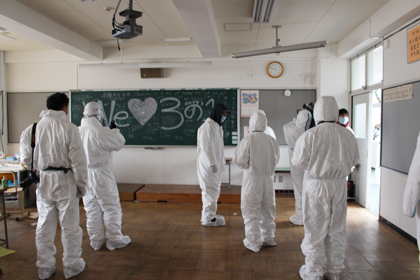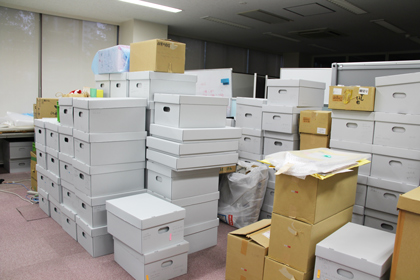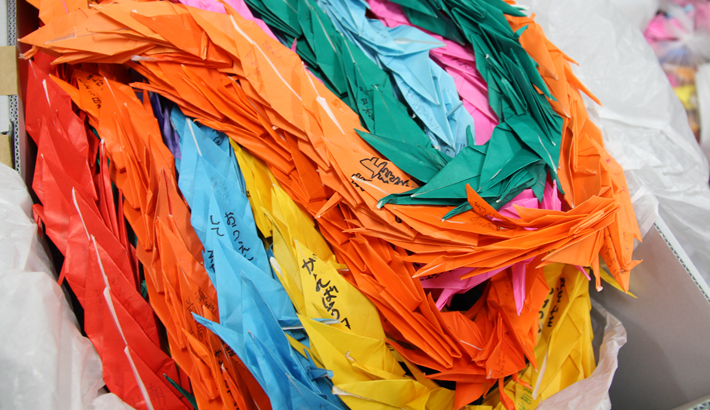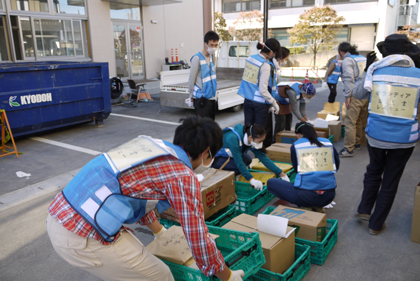TSUKUBA FRONTIER
#12 From Ancient Texts and Official Documents to Disaster Records: A Global Standard for Connecting Local History
Information on how and where local historical documents are stored has a great bearing on the meaning of the documents themselves. Professor Shirai has constructed a standard for recording the documents and the condition in which they were found, and for storing and utilizing them.
Professor SHIRAI Tetsuya, Faculty of Library, Information and Media Science

■ Archival science and disaster related documents

Futaba is a town in Fukushima Prefecture which was devastated by the Great East Japan Earthquake and the subsequent nuclear accident. As soon as the population were moved into refuge centers, a policy to compile detailed records of the disaster was drawn up. The key to this was "archival science." The University of Tsukuba, one of the few research institutes in Japan active in this field, undertook a joint initiative with Futaba to preserve all disaster related documents as a step towards reconstruction. These are now published on a website entitled "Preserving Futaba Town's Archive Materials of the Great East Japan Earthquake for Future Generations."
Preservation of documents is not just classification and sorting. It is different to the preservation of cultural assets also. In archival science, great importance is attached to the "provenance" of the document: where it was found, what condition it was in, what other documents were found in the same place, the documents' movements, etc. These determine the significance and the role of the document. By connecting the documents to the above information, even if there are a large number of similar documents, they can be thought of as one.
■ In search of "bonds"

When the Futaba town hall, which had been transferred to Saitama after the disaster, moved to Iwaki in 2013, all disaster documents which were to be preserved were brought to the University of Tsukuba. In total there were 170 cardboard boxes, including tens of thousands of local photographs. The documents included information about the course of evacuation from the time the disaster hit up to the present, images of streetscapes and refuge centers, and aid and messages of encouragement sent from Japan and around the world. The documents were in a variety of forms: letters, photographs, message boards and even strings of paper cranes. There were even such documents as order forms for packed lunches handed out in refuge centers, and records of volunteer activities.
The strings of paper cranes were particularly interesting. There were seventy in total, each made of many different types of paper. Some strings had a message written inside each crane, which gave a real insight into the feelings of the people who had made them. It was particularly interesting that the nuclear accident was mentioned in heartfelt letters sent by children from overseas soon after the earthquake, showing that a relatively clear picture of the situation was transmitted around the world while information in Japan was still confusing and facts were hard to come by. The vision and imagination required for careful observation of documents and the examination of traces of the past hidden in the details, are important elements of archival science.
The word "bonds" was used a lot at the time of the earthquake, but what kind of bonds were people talking about? These messages give us a unique insight into this. Digital records are indispensable if enormous amounts of data are to be stored, but the amount of information that can be gathered from the originals is incomparable. Memories of the disaster are recorded through careful selection and evaluation of both digital and analog information.

■ Creating a document preservation system

Prof. Shirai is also involved in research into the universalization of document preservation management in times of disaster. Links between the public and private sectors are broken, meaning that records and official documents cannot be dealt with. Even with a large number of volunteers, documents will not be preserved correctly unless there is a proper mechanism for leadership, provision of instructions, and for coordinating communications between affected organizations.
Prof. Shirai's conceptions and experience were stretched to the limits in the flood which hit Joso City last September. Approximately half of the 25,000 official documents stored in the city hall, including precious material from the Edo period, were submerged. Alongside rescuing the documents, Prof. Shirai is collaborating with the local administration on the establishment of a management system for the future.
■ Creating an archive we can all contribute to
The value of archived material is only manifested when people read it and use it. Modern digital archive technology has made material far more accessible. Plans are under way to enable people who visit Futaba's disaster archive website to contribute new information, which will allow any member of the public to utilize the data.
This mechanism is known as microtask crowdsourcing, a service which enables an unlimited number of users to carry out simple tasks like inputting data; the data is then collated to help find solution for problems. This can be adapted to enable website users to tag their own documents, such as photos taken in the aftermath of an earthquake, in their own language. In this way the users take ownership of the document and share it with other users around the world. In the near future we will have a new type of archive based on interactive communication.
In contemporary society, in which work and home have become separate, fewer families live in the same place for generations, and many people move away from their home towns. Against this backdrop, an important task for archive science is to determine how disaster related documents, which function as local history, will be passed on to future generations.
Article by Science Communicator at the Office of Public Relations


